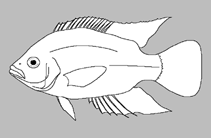Gymnogeophagus peliochelynion Turcati, Serra-Alanis & Malabarba, 2018
Upload your photos and videos
Pictures | Google imageNo image available for this species;
drawing shows typical species in Cichlidae.
Pictures | Google imageNo image available for this species;
drawing shows typical species in Cichlidae.
Common names from other countries
Classification / Names Common names | Synonyms | Catalog of Fishes(genus, species) | ITIS | CoL | WoRMS | Cloffa
Teleostei (teleosts) > Cichliformes (Cichlids, convict blennies) > Cichlidae (Cichlids) > Geophaginae
Etymology: Gymnogeophagus: Greek, gymnos = naked + Greek, gea = the earth + Greek, phaegein, to eat (Ref. 45335); peliochelynion: Name from Greek 'pelios' meaning black and blue, and 'chelyne' for lip, referring to the color of the lips of the new species; noun in apposition.
Etymology: Gymnogeophagus: Greek, gymnos = naked + Greek, gea = the earth + Greek, phaegein, to eat (Ref. 45335); peliochelynion: Name from Greek 'pelios' meaning black and blue, and 'chelyne' for lip, referring to the color of the lips of the new species; noun in apposition.
Issue
Entered from e-publication.
Environment: milieu / climate zone / depth range / distribution range Ecology
Freshwater; benthopelagic. Tropical
Distribution Countries | FAO areas | Ecosystems | Occurrences | Point map | Introductions | Faunafri
South America: Uruguay.
Size / Weight / Age
Short description Identification keys | Morphology | Morphometrics
Dorsal spines (total): 12 - 14; Dorsal soft rays (total): 9 - 11; Anal spines: 3; Anal soft rays: 8 - 9. This species is distinguished from its congeners of the rhabdotus group and fromG. balzanii by the shape of the caudal peduncle which is longer than deep (vs. deeper than long); differs from all congeners, except labiatus and pseudolabiatus, by having thick lips; differs from labiatus and lacustris by the absence of an oblique bar from the eye to the dorsal-fin origin (vs. present), and by the color pattern of the caudal, dorsal and anal fins with dots (vs. caudal fin and posterior portion of anal fin with longitudinal hyaline stripes); differs from pseudolabiatus and mekinos by the hump entirely black in males (vs. yellow with black margin), and the upper lip not folded dorsally over anterior margin of snout (vs. folded dorsally, usually with a well-developed medial lobe dorsally projected in pseudolabiatus) (Ref. 123558).
Collected in rivers with clear water, usually with rocky or muddy bottom and little vegetation (Ref. 123558).
Life cycle and mating behavior Maturity | Reproduction | Spawning | Eggs | Fecundity | Larvae
Main reference
Upload your references | References | Coordinator : Kullander, Sven O. | Collaborators
Turcati, A., W.S. Serra-Alanis and L.R. Malabarba, 2018. A new mouth brooder species of Gymnogeophagus with hypertrophied lips (Cichliformes: Cichlidae). Neotropical Ichthyol. 16(4): e180118: 1-9. [First published online with fixed layout, pp. 1-9, 14 Dec. 2018.] (Ref. 123558)
Threat to humans
Harmless
Human uses
FAO(Publication : search) | FishSource |
More information
Trophic ecology
Food items
Diet composition
Food consumption
Food rations
Predators
Food items
Diet composition
Food consumption
Food rations
Predators
Ecology
Ecology
Home ranges
Ecology
Home ranges
Population dynamics
Growth parameters
Max. ages / sizes
Length-weight rel.
Length-length rel.
Length-frequencies
Mass conversion
Recruitment
Abundance
Growth parameters
Max. ages / sizes
Length-weight rel.
Length-length rel.
Length-frequencies
Mass conversion
Recruitment
Abundance
Life cycle
Reproduction
Maturity
Fecundity
Spawning
Spawning aggregations
Eggs
Egg development
Larvae
Larval dynamics
Reproduction
Maturity
Fecundity
Spawning
Spawning aggregations
Eggs
Egg development
Larvae
Larval dynamics
Anatomy
Gill area
Brain
Otolith
Gill area
Brain
Otolith
Physiology
Body composition
Nutrients
Oxygen consumption
Swimming type
Swimming speed
Visual pigments
Fish sound
Diseases & Parasites
Toxicity (LC50s)
Body composition
Nutrients
Oxygen consumption
Swimming type
Swimming speed
Visual pigments
Fish sound
Diseases & Parasites
Toxicity (LC50s)
Genetics
Genetics
Heterozygosity
Heritability
Genetics
Heterozygosity
Heritability
Human related
Aquaculture systems
Aquaculture profiles
Strains
Ciguatera cases
Stamps, coins, misc.
Aquaculture systems
Aquaculture profiles
Strains
Ciguatera cases
Stamps, coins, misc.
Tools
E-book | Field guide | Length-frequency wizard | Life-history tool | Point map | Classification Tree
| Catch-MSY |
Special reports
Download XML
Internet sources
Aquatic Commons | BHL | Cloffa | Websites from users | Check FishWatcher | CISTI | Catalog of Fishes(genus, species) | DiscoverLife | ECOTOX | Faunafri | Fishtrace | GenBank(genome, nucleotide) | GloBI | GOBASE | | Google Books | Google Scholar | Google | IGFA World Record | MitoFish | National databases | Otolith Atlas of Taiwan Fishes | PubMed | Reef Life Survey | Scirus | SeaLifeBase | Tree of Life | Wikipedia(Go, Search) | World Records Freshwater Fishing | Zoobank | Zoological Record
Estimates based on models
Phylogenetic diversity index (Ref. 82804): PD50 = No PD50 data [Uniqueness, from 0.5 = low to 2.0 = high].
Bayesian length-weight: a=0.01995 (0.00926 - 0.04297), b=3.01 (2.83 - 3.19), in cm Total Length, based on LWR estimates for this (Sub)family-body shape (Ref. 93245).
Trophic level (Ref. 69278): 3.3 ±0.5 se; based on size and trophs of closest relatives
Resilience (Ref. 120179): High, minimum population doubling time less than 15 months (Preliminary K or Fecundity.).
Fishing Vulnerability (Ref. 59153): Low vulnerability (10 of 100).




